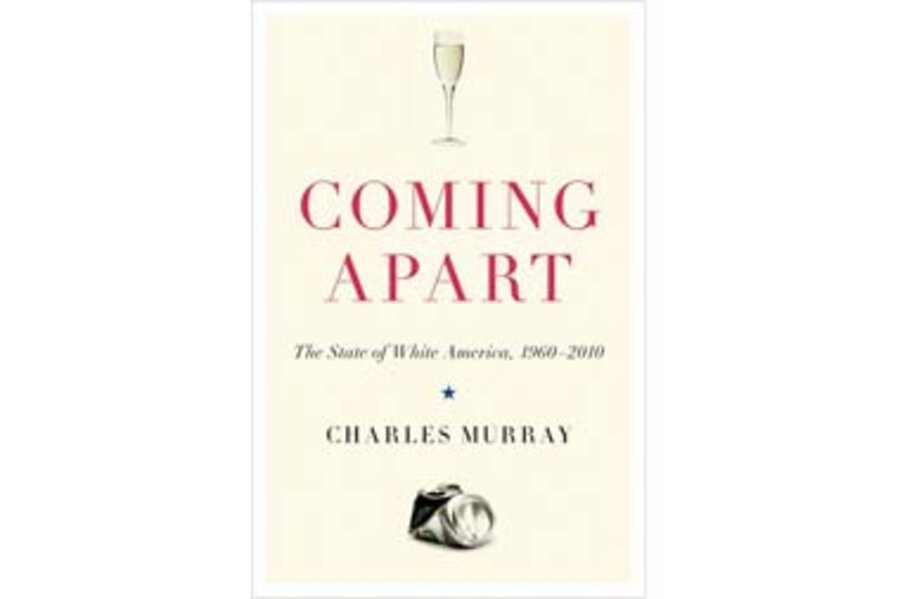'Coming Apart': Charles Murray sees an America divided, but not by race
As the topic of inequality reemerges in the national conversation and stirs controversy on the national airwaves – from “Occupy” protests to the “I don’t care about the very poor” Mitt Romney gaffe – a contentious new book by social scientist Charles Murray is adding fuel to the firestorm.
“Coming Apart: The State of White America, 1960-2010” boldly describes an America that is “coming apart at the seams.” Murray paints a picture of a deep social and cultural schism dividing Americans into an upper class defined by educational attainment, professional productivity, traditional values, and shared cultural norms, and a lower class characterized by the opposite – lack of education, lack of industriousness, a breakdown of traditional values like marriage, and a widespread political and social disengagement. The result, writes Murray, is a social balkanization of American society that has political ramifications and is only bound to deepen over time.
“The people who run the country have enormous influence over the culture, politics, and the economics of the country,” Murray said in an interview with NPR. “And increasingly, they haven’t a clue about how most of America lives. They have never experienced it. They don’t watch the same movies, they don’t watch the same television shows – they don’t watch television at all, in many cases – and when that happens, you get some policies that are pretty far out of whack.”
Of course, to understand “Coming Apart” is to understand the man behind it, a libertarian social scientist who has become a pariah of sorts for his 1994 book with Richard J. Herrnstein, “The Bell Curve.” The 845-page book about race, class, genetics, and I.Q. was denounced by social scientists, liberal academics, even, writes The New York Times, “a little-known Chicago civil-rights lawyer named Barack Obama, who in a commentary on NPR accused the authors of calculating that ‘white America is ready for a return to good old-fashioned racism as long as it's artfully packaged.’”
In contrast, "Coming Apart" focuses only on whites (to show class divisions transcend race), painting a picture of an America “increasingly polarized into two culturally- and geographically-isolated demographics,” as the NYT explains. In upscale Belmont, “divorce is low, the work ethic is strong, religious observance is high, and out-of-wedlock births are all but unheard of.”
“Meanwhile, in Fishtown, where the bottom 30 percent live, what Mr. Murray calls America’s four ‘founding virtues; - marriage, industriousness, community and faith – have all but collapsed.”
In the book, Murray calls for more interaction between “Belmont” and “Fishtown,” specifically for upper-middle class Americans to “drop their nonjudgmentalism and start preaching what they’re practicing.”
It’s a stark contrast with a controversial prescription. Not surprisingly, “Coming Apart” has sharply divided readers.
“I’ll be shocked,” writes noted conservative and New York Times columnist David Brooks, “if there’s another book this year as important as Charles Murray’s ‘Coming Apart.’”
He goes on to praise Murray for bursting the ideological class-divide bubble both parties have been blowing hot air into: “Republicans claim that America is threatened by a decadent cultural elite that corrupts regular Americans, who love God, country, and traditional values,” Brooks writes. “That story is false. The cultural elites live more conservative, traditional lives than the cultural masses.”
“Democrats claim America is threatened by the financial elite, who hog society’s resources. But that’s a distraction…The liberal members of the upper tribe latch onto this top 1 percent narrative because it excuses them from the central role they themselves are playing in driving inequality and unfairness.”
But New York Magazine’s Jonathan Chait calls Brooks’ argument, above, a “sleight of hand” that Murray’s latest work has enabled conservatives to perform to “safely steer the [inequality] debate back onto comfortable conservative terrain.”
“The appearance of income inequality on the political agenda has left conservatives casting about for a response,” writes Chait, "and after several months of floundering, it has increasingly narrowed down to two words: Charles Murray.” Chait goes on to write that the focus on deteriorating social norms is simply “an attempt to change the subject” from “the problem of income inequality.”
But perhaps the most impassioned critique comes from conservative Republican journalist and former speechwriter for George W. Bush, David Frum, in a review in the Daily Beast.
Frum calls “Coming Apart” “an important book that will have a large influence. It is unfortunately not a good book,” he writes, arguing that Murray details the social problems that have burdened the working class with “remarkable – and telltale – uncuriosity as to why any of this might be happening.”
“'Coming Apart' is an important book less because of what it says than because of what it omits,” he writes, “less for the information it contains than for the uses to which that information will be put."
No doubt “Coming Apart” will continue to divide readers. But if it sparks awareness, conversation, and hopefully, action towards uniting Americans, then perhaps it will have accomplished what it was after.
Husna Haq is a Monitor correspondent.





